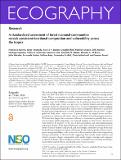Files in this item
A standardized assessment of forest mammal communities reveals consistent functional composition and vulnerability across the tropics
Item metadata
| dc.contributor.author | Rovero, Francesco | |
| dc.contributor.author | Ahumada, Jorge | |
| dc.contributor.author | Jansen, Patrick A. | |
| dc.contributor.author | Sheil, Douglas | |
| dc.contributor.author | Alvarez, Patricia | |
| dc.contributor.author | Boekee, Kelly | |
| dc.contributor.author | Espinosa, Santiago | |
| dc.contributor.author | Lima, Marcela Guimarães Moreira | |
| dc.contributor.author | Martin, Emanuel H. | |
| dc.contributor.author | O'Brien, Timothy G. | |
| dc.contributor.author | Salvador, Julia | |
| dc.contributor.author | Santos, Fernanda | |
| dc.contributor.author | Rosa, Melissa | |
| dc.contributor.author | Zvoleff, Alexander | |
| dc.contributor.author | Sutherland, Chris | |
| dc.contributor.author | Tenan, Simone | |
| dc.date.accessioned | 2021-06-03T15:30:01Z | |
| dc.date.available | 2021-06-03T15:30:01Z | |
| dc.date.issued | 2020-01 | |
| dc.identifier | 272474767 | |
| dc.identifier | df84f697-2436-4ba0-af30-25dad5a66438 | |
| dc.identifier | 85074791362 | |
| dc.identifier.citation | Rovero , F , Ahumada , J , Jansen , P A , Sheil , D , Alvarez , P , Boekee , K , Espinosa , S , Lima , M G M , Martin , E H , O'Brien , T G , Salvador , J , Santos , F , Rosa , M , Zvoleff , A , Sutherland , C & Tenan , S 2020 , ' A standardized assessment of forest mammal communities reveals consistent functional composition and vulnerability across the tropics ' , Ecography , vol. 43 , no. 1 , pp. 75-84 . https://doi.org/10.1111/ecog.04773 | en |
| dc.identifier.issn | 0906-7590 | |
| dc.identifier.other | ORCID: /0000-0003-2073-1751/work/87404639 | |
| dc.identifier.uri | https://hdl.handle.net/10023/23307 | |
| dc.description | Funding: Data in this publication were provided by the Tropical Ecology Assessment and Monitoring (TEAM) Network, a collaboration between Conservation International, the Smithsonian Inst., and the Wildlife Conservation Society, and partially funded by these institutions, the Gordon and Betty Moore Foundation, and other donors. | en |
| dc.description.abstract | The understanding of global diversity patterns has benefitted from a focus on functional traits and how they relate to variation in environmental conditions among assemblages. Distant communities in similar environments often share characteristics, and for tropical forest mammals, this functional trait convergence has been demonstrated at coarse scales (110–200 km resolution), but less is known about how these patterns manifest at fine scales, where local processes (e.g. habitat features and anthropogenic activities) and biotic interactions occur. Here, we used standardized camera trapping data and a novel analytical method that accounts for imperfect detection to assess how the functional composition of terrestrial mammal communities for two traits – trophic guild and body mass – varies across 16 protected areas in tropical forests and three continents, in relation to the extent of protected habitat and anthropogenic pressures. We found that despite their taxonomic differences, communities generally have a consistent trophic guild composition, and respond similarly to these factors. Insectivores were found to be sensitive to the size of protected habitat and surrounding human population density. Body mass distribution varied little among communities both in terms of central tendency and spread, and interestingly, community average body mass declined with proximity to human settlements. Results indicate predicted trait convergence among assemblages at the coarse scale reflects consistent functional composition among communities at the local scale, suggesting that broadly similar habitats and selective pressures shaped communities with similar trophic strategies and responses to drivers of change. These similarities provide a foundation for assessing assemblages under anthropogenic threats and sharing conservation measures. | |
| dc.format.extent | 10 | |
| dc.format.extent | 1051736 | |
| dc.language.iso | eng | |
| dc.relation.ispartof | Ecography | en |
| dc.subject | Community structure | en |
| dc.subject | Conservation | en |
| dc.subject | Functional traits | en |
| dc.subject | Mammals | en |
| dc.subject | Trophic guild | en |
| dc.subject | Tropical forest | en |
| dc.subject | GF Human ecology. Anthropogeography | en |
| dc.subject | QA Mathematics | en |
| dc.subject | QH301 Biology | en |
| dc.subject | Ecology, Evolution, Behavior and Systematics | en |
| dc.subject | 3rd-DAS | en |
| dc.subject | SDG 15 - Life on Land | en |
| dc.subject.lcc | GF | en |
| dc.subject.lcc | QA | en |
| dc.subject.lcc | QH301 | en |
| dc.title | A standardized assessment of forest mammal communities reveals consistent functional composition and vulnerability across the tropics | en |
| dc.type | Journal article | en |
| dc.contributor.institution | University of St Andrews. Statistics | en |
| dc.contributor.institution | University of St Andrews. Centre for Research into Ecological & Environmental Modelling | en |
| dc.identifier.doi | 10.1111/ecog.04773 | |
| dc.description.status | Peer reviewed | en |
This item appears in the following Collection(s)
Items in the St Andrews Research Repository are protected by copyright, with all rights reserved, unless otherwise indicated.

